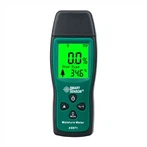Advantages and Disadvantages of Non-Contact Thermometers
Non-contact temperature measuring instruments are designed based on the principle of thermal radiation of objects. when measuring. The temperature sensing element is not in direct contact with the object to be measured and is usually used to measure temperatures above 1000°C. The temperature or surface temperature of a hot object that moves, rotates, or reacts rapidly.
The advantages are:
(1) Wide temperature measurement range (theoretically there is no upper limit). Suitable for high temperature measurement;
(2) The temperature field of the measured object will not be destroyed during the temperature measurement process. Does not affect the original temperature field distribution;
(3) Can measure the temperature of moving objects;
(4) Thermal inertia is small. Detector response time is short. The temperature measurement response speed is fast. About 2-3s, easy to achieve fast and dynamic temperature measurement. Under certain conditions, such as nuclear radiation fields. Radiation thermometry allows for accurate and reliable measurements.
The disadvantages of non-contact temperature measurement instruments are:
(I) It cannot directly measure the true temperature of the measured object. To get the real temperature. Emissivity correction is required. The emissivity is a parameter with quite complex influencing factors. This increases the difficulty of processing the measurement results.
(2) Because it is non-contact. The measurement of radiation thermometer is greatly affected by the intermediate medium. The treatment is under industrial site conditions. The surrounding environment is relatively harsh, and the intermediate medium has a greater impact on the measurement results. in this regard. The choice of thermometer wavelength range is very important.
(3) Due to the complexity of the principle of radiation temperature measurement. As a result, the thermometer has a complicated structure and a higher price.
Non-contact temperature measurement instruments mainly include radiation thermometers, fiber optic radiation thermometers, etc. The former is divided into total radiation thermometers, brightness thermometers (optical pyrometer, photoelectric pyrometer) and colorimetric thermometers.






